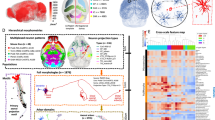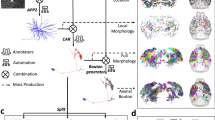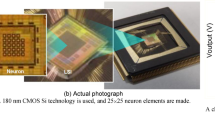Abstract
Neuron morphology has been extensively reconstructed at the whole-brain scale by various projects in recent years. Here, to facilitate interactive exploration in a standardized and scalable manner, we introduce NeuroXiv (neuroxiv.org), a large-scale database containing 175,149 reconstructed neuron morphologies mapped to the Common Coordinate Framework Version 3 (CCFv3). In addition, NeuroXiv incorporates an AI-powered mining engine (AIPOM) for dynamic, user-specific data mining, delivering enhanced performance via a custom client program.
This is a preview of subscription content, access via your institution
Access options
Access Nature and 54 other Nature Portfolio journals
Get Nature+, our best-value online-access subscription
$32.99 / 30 days
cancel any time
Subscribe to this journal
Receive 12 print issues and online access
$259.00 per year
only $21.58 per issue
Buy this article
- Purchase on SpringerLink
- Instant access to full article PDF
Prices may be subject to local taxes which are calculated during checkout


Similar content being viewed by others
Data availability
Atlas-mapped neuronal morphology data and discovery results—including metadata, figures and mining text—are available for direct download via the web portal (https://neuroxiv.org). In addition, we have set up an AWS server (https://download.neuroxiv.org) to facilitate easy access to standardized datasets. VTK files for various brain regions in CCFv3 are also available via GitHub at https://github.com/SEU-ALLEN-codebase/NeuroXiv/VTK. All the materials available from NeuroXiv should only be used exclusively for academic purposes and must adhere to the CC-BY NC license (https://creativecommons.org/licenses/by-nc/4.0/legalcode). Source data are provided with this paper.
Code availability
The source code of the NeuroXiv project is available via GitHub at https://github.com/SEU-ALLEN-codebase/NeuroXiv, where detailed deployment instructions are provided. User manuals and video tutorials are available at our website (https://neuroxiv.org). Data processing utilizes the plugin system provided by the Vaa3D platform (version 4.001, available via GitHub at https://github.com/Vaa3D). The source code for quality control procedures is available via GitHub at https://github.com/Vaa3D/vaa3d_tools/tree/master/hackathon/shengdian/NeuroMorphoLib. The source code for mBrainAlinger is available via GitHub at https://github.com/Vaa3D/vaa3d_tools/tree/master/hackathon/mBrainAligner. Atlas mapping can also be conducted via the mBrainAlinger web portal (http://mbrainaligner.ahu.edu.cn). All code is available under an open-source MIT license.
References
Zeng, H. & Sanes, J. R. Neuronal cell-type classification: challenges, opportunities and the path forward. Nat. Rev. Neurosci. 18, 530–546 (2017).
Aransay, A., Rodríguez-López, C., García-Amado, M., Clascá, F. & Prensa, L. Long-range projection neurons of the mouse ventral tegmental area: a single-cell axon tracing analysis. Front. Neuroanat. 9, 59 (2015).
Gong, H. et al. High-throughput dual-colour precision imaging for brain-wide connectome with cytoarchitectonic landmarks at the cellular level. Nat. Commun. 7, 12142 (2016).
Bria, A., Iannello, G., Onofri, L. & Peng, H. TeraFly: real-time three-dimensional visualization and annotation of terabytes of multidimensional volumetric images. Nat. Methods 13, 192–194 (2016).
Manubens-Gil, L. et al. BigNeuron: a resource to benchmark and predict performance of algorithms for automated tracing of neurons in light microscopy datasets. Nat. Methods https://doi.org/10.1038/s41592-023-01848-5 (2023).
Peng, H. et al. Morphological diversity of single neurons in molecularly defined cell types. Nature 598, 174–181 (2021).
Liu, Y. et al. Neuronal diversity and stereotypy at multiple scales through whole brain morphometry. Nat. Commun. 15, 10269 (2024).
Xiong, F. et al. DSM: deep sequential model for complete neuronal morphology representation and feature extraction. Patterns 5, 100896 (2024).
Qiu, S. et al. Whole-brain spatial organization of hippocampal single-neuron projectomes. Science 383, eadj9198 (2024).
Winnubst, J. et al. Reconstruction of 1,000 projection neurons reveals new cell types and organization of long-range connectivity in the mouse brain. Cell 179, 268–281 (2019).
Kenney, M. et al. The Brain Image Library: a community-contributed microscopy resource for neuroscientists. Sci. Data 11, 1212 (2024).
Ascoli, G. A., Maraver, P., Nanda, S., Polavaram, S. & Armañanzas, R. Win–win data sharing in neuroscience. Nat. Methods 14, 112–116 (2017).
Timonidis, N. et al. Translating single-neuron axonal reconstructions into meso-scale connectivity statistics in the mouse somatosensory thalamus. Front. Neuroinform. 17, 1272243 (2023).
Wang, Q. et al. The Allen Mouse Brain Common Coordinate Framework: a 3D reference atlas. Cell 181, 936–953 (2020).
Mehta, K. et al. Online conversion of reconstructed neural morphologies into standardized SWC format. Nat. Commun. 14, 7429 (2023).
Gao, L. et al. Single-neuron projectome of mouse prefrontal cortex. Nat. Neurosci. 25, 515–529 (2022).
Gao, L. et al. Single-neuron analysis of dendrites and axons reveals the network organization in mouse prefrontal cortex. Nat. Neurosci. 26, 1111–1126 (2023).
Bzdok, D. et al. Data science opportunities of large language models for neuroscience and biomedicine. Neuron 112, 698–717 (2024).
Rubio-Teves, M. et al. Beyond barrels: diverse thalamocortical projection motifs in the mouse ventral posterior complex. J. Neurosci. 44, e1096242024, (2024).
Li, Y., Jiang, S., Ding, L. & Liu, L. NRRS: a re-tracing strategy to refine neuron reconstruction. Bioinform. Adv. 3, vbad054 (2023).
Guo, S., Zhao, X., Jiang, S., Ding, L. & Peng, H. Image enhancement to leverage the 3D morphological reconstruction of single-cell neurons. Bioinformatics 38, 503–512 (2022).
Xiao, H. & Peng, H. APP2: automatic tracing of 3D neuron morphology based on hierarchical pruning of a gray-weighted image distance-tree. Bioinformatics 29, 1448–1454 (2013).
Feng, L., Zhao, T. & Kim, J. neuTube 1.0: a new design for efficient neuron reconstruction software based on the SWC format. eNeuro https://doi.org/10.1523/eneuro.0049-14.2014 (2015).
Zhao, Z.-H., Liu, L. & Liu, Y. NIEND: neuronal image enhancement through noise disentanglement. Bioinformatics 40, btae158 (2024).
Qu, L. et al. Cross-modal coherent registration of whole mouse brains. Nat. Methods 19, 111–118 (2022).
Li, Y. et al. mBrainAligner-Web: a web server for cross-modal coherent registration of whole mouse brains. Bioinformatics 38, 4654–4655 (2022).
Lorensen, W. E. & Cline, H. E. Marching cubes: a high resolution 3D surface construction algorithm. In Seminal Graphics: Pioneering Efforts That Shaped the Field https://doi.org/10.1145/280811.281026 (1998).
Vollmer, J., Mencl, R. & Müller, H. Improved Laplacian smoothing of noisy surface meshes. Comput. Graph. Forum 18, 131–138 (1999).
Acknowledgements
This project was mainly supported by several grants awarded to H.P. H.P. is a New Cornerstone Investigator and a SANS Senior Investigator. The Southeast University team was also supported by a MOST (China) Brain Research Project, ‘Mammalian Whole Brain Mesoscopic Stereotaxic 3D Atlas’ (project numbers 2022ZD0205200 and 2022ZD0205204) awarded to L.L. We thank Brain Science Data Center, Chinese Academy of Sciences (https://braindatacenter.cn/) for the open sharing of ION datasets. We thank MouseLight project (http://ml-neuronbrowser.janelia.org) for the open sharing of its dataset. We extend our gratitude to X. Zhao for early involvement in the project’s development. We also thank S. Zhao for assisting with the use of the auto-arbor tool to generate arbor data for all axon-containing neurons, and X. Jiang for testing NeuroXiv’s functionalities and drafting the NeuroXiv user manual.
Author information
Authors and Affiliations
Contributions
H.P. conceptualized and managed this study, and invented AIPOM. Z.Y., L.L., H.C. and J.Y. designed the initial version of the NeuroXiv (neuroxiv.net) platform, hosted originally on Tencent Cloud server. Z.Y. was responsible for backend development of the first-generation platform, while H.C. handled frontend coding. S.J. and L.W. codeveloped the new version of the NeuroXiv (neuroxiv.org) platform and migrated the servers to the AWS cloud platform. L.W. undertook the majority of website development tasks, including project deployment as well as backend and frontend development. S.J. managed the data aggregation tasks, including data standardization processing, metadata generation and the production of required atlases and reconstruction files (OBJ files) for the website. H.P. and S.J. wrote the manuscript with assistance from all authors, who reviewed and revised the manuscript.
Corresponding authors
Ethics declarations
Competing interests
H.C. and J.Y. were employed by Tencent AI Lab when this work was done. The company did not influence the research. The other authors declare no competing interests.
Peer review
Peer review information
Nature Methods thanks Yongsoo Kim and the other, anonymous, reviewer(s) for their contribution to the peer review of this work. Primary Handling Editor: Nina Vogt, in collaboration with the Nature Methods team.
Additional information
Publisher’s note Springer Nature remains neutral with regard to jurisdictional claims in published maps and institutional affiliations.
Extended data
Extended Data Fig. 1 Local dendrites in the NeuroXiv database.
a, the statistics of the number of local dendrites in different brain regions within the CCFv3 atlas. b, Visualization of local dendritic data across various brain regions. Local dendrites are rendered in distinct colors to enhance differentiation.
Extended Data Fig. 2 Gains in improvements resulting from data aggregation.
The NeuroXiv database was compared with three other data sources across multiple parameters. In all comparative analyses, gray bars indicate the maximum values obtainable from other individual data sources. Colored bars demonstrate improvements achieved using the NeuroXiv database. a, neurite arborization. Total arborized length across brain regions, with separate measurements for axonal and dendritic processes. b, projection combinations. Number of distinct projection patterns between brain regions, considering only neurons with processes extending >1000 μm into target regions. c, neuronal proximity. three categories of neighboring neurons: soma-neighboring, axon-neighboring and dendrite-neighboring. d, neuronal similarity. two classification types: projection-similar and morphology-similar. (See Extended Data Fig. 3 for precise definitions of neighboring and similar neuron classifications.).
Extended Data Fig. 3 Illustrative diagrams depicting the definition of correlated neuron data on the NeuroXiv platform.
a, projection similarity neurons are defined by the distance measured between key axonal nodes of the neurons, including the soma, bifurcation points, and terminal points. b, morphological similarity neurons are defined by calculating the distance between neuron pairs in morphological feature space. In the database, we rank similarity based on the distances, with closer distances indicating greater similarity. c and d, Axon neighboring neurons are those where the axonal arbor of neurons in the database spatially overlaps with the dendritic arbor of the subject neuron. Conversely, dendrite neighboring neurons are those where the dendritic arbor of neurons in the database spatially overlaps with the axonal arbor of the subject neuron. In the database, we rank neighboring neurons based on the length of the overlapping arbor regions, with greater lengths indicating higher proximity.
Extended Data Fig. 4 Interactive visualization diagram of NeuroXiv.
a, we have implemented a 3D viewer on the web platform, allowing users to visualize the atlas and neurons or neuronal structures of interest. b, visualization of individual neuron data, featuring an embedded arbor viewer with zoom-in views of basal and apical dendrites. c, arbor distribution of major cell types across various brain regions. We also visualize arbor distribution across different cortical layers.
Extended Data Fig. 5 An illustrative diagram of data retrieval and filtering on the NeuroXiv platform.
a, each neuron reconstruction in the NeuroXiv database is assigned a unique ID and includes three types of metadata: basic information, morphological features, and projection characteristics. b, users can customize their search strategies using either the ID or the metadata. c, to facilitate efficient data filtering, we have implemented a neuron browser on the web portal. This tool displays the morphology of each neuron (neuron thumbnail) and key information, and includes an entry point for navigating to detailed data pages. d, users can define regions of interest (ROI) and then retrieve neurons with soma located within these ROI (Supplementary Fig. 6).
Extended Data Fig. 6 A case study of neuron projection research using NeuroXiv.
a, this study includes 417 VPM neurons from two sources. Overall, VPM neurons project through the CP brain region, bifurcating at the boundary of the CP region to target cortical brain areas. Based on combinations of target brain regions, eight subtypes of projections are identified. Subtype P8 (characterized by neurons projecting to VISp) was excluded from subsequent analyses. b, differences in projection strength among various projection types in target brain regions and cortical layers are visualized, with projection strength determined by axonal length. c, VPM neurons exhibit projection selectivity across cortical layers. For instance, neurons projecting solely to the SSp-n region form clusters while skipping L5, whereas neurons projecting solely to the SSp-m or SSp-bfd regions form clusters while skipping L4. d and e, differences in soma distribution and morphological characteristics among various VPM projection subtypes are analyzed. In this figure, box edges in box plots show 25th and 75th percentiles, the centre line shows the 50th percentile, and bars show 1.5× the interquartile range (75th percentile – 25th percentile).
Extended Data Fig. 7 A schematic illustration of the mixture of experts (MoE) system.
The MoE-based report generation process can be divided into three distinct stages. 1) Descriptive reports generation: A program generates reports in a fixed format, capturing all relevant details of the retrieved data. 2) LLM Expert reports: Multiple LLM Experts analyze and summarize the descriptive reports from a data scientist’s perspective. Although three experts are shown, the process can involve one or more. 3) Report confirmation: A different LLM Expert evaluates the previous reports for accuracy, readability, and coherence, and refines the final report accordingly. An actual case is shown on the far right, with red arrows pointing to the reports generated at each stage.
Supplementary information
Supplementary Information
Supplementary Figs. 1–12 and Notes 1 and 2.
Supplementary Table 1–3
The definition of items used in NeuroXiv.
Source data
Source Data Fig. 1
Statistical source data of Fig. 1c.
Source Data Fig. 2
Statistical source data of Fig. 2d,e.
Rights and permissions
Springer Nature or its licensor (e.g. a society or other partner) holds exclusive rights to this article under a publishing agreement with the author(s) or other rightsholder(s); author self-archiving of the accepted manuscript version of this article is solely governed by the terms of such publishing agreement and applicable law.
About this article
Cite this article
Jiang, S., Wang, L., Yun, Z. et al. NeuroXiv: AI-powered open databasing and dynamic mining of brain-wide neuron morphometry. Nat Methods 22, 1195–1198 (2025). https://doi.org/10.1038/s41592-025-02687-2
Received:
Accepted:
Published:
Issue date:
DOI: https://doi.org/10.1038/s41592-025-02687-2



